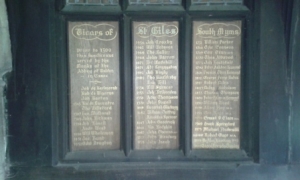Archive: Vicars of South Mymms
VICARS OF SOUTH MYMMS
At a quiet moment before the ceremony of installing Revd. Karen as the latest in a long line of Priests at St. Giles South Mymms, I happened to look (for once) at the boards containing the names of her predecessors, which are in the porch to the right of the church door. Normally we just walk past without looking.
The Board names them as Vicars. Vicars were frequently absentees from their parishes, which were mainly a source of income: they used clerks to stand in and actually officiate, at least until the later 1800s. So some of my speculations may not have been affected by these people actually having lived in South Mymms. Some of them also held more than one parish: Freddie Brittain names some nine of these in his history of the village, one of whom (John Jacob, 1773-90) was also Vicar of St. Margaret’s Ridge, which otherwise has quite a different history and origin from St. Giles.
One thing which struck me was the large number of vicars succeeding each other in the later Middle Ages, and the brevity of their tenure in office. The first date on the board is 1365, with three names before that – and before 1300 services were taken by monks from Walden Abbey, which was at Saffron Walden. This seems a long way to come from – surely there were abbeys nearer, like St. Albans. The answer is that the manors of Enfield, North Mymms and Shenley were given by William the Conqueror to Geoffrey Earl of Mandeville, including the land which became known as South Mymms (however spelled). A descendent, also Geoffrey, founded the abbey of St. James at Saffron Walden. And the little church, possibly built around 1136, was provided with priests from that abbey.
The board lists 54 names: Revd. Karen is the 55th. One day we will need to find space for a new board, as all three boards are quite full. The vicars named mostly have the dates of their installation, so we can work out how long they stayed. Over the centuries it is noticeable that some only stayed a year or two, while others lasted 20 years or more. In 1471, one vicar lasted less than a year, and was replaced later that year. (That was before the Church of England came into being with its arrangements for ensuring a nice long vacancy between priests!). Others stayed for 20, 30 or 40 or more years.
So why would there be such divergence in tenure at South Mymms? Some of it might be attributed to political unrest. Priests during the Wars of the Roses (dates on the board from 1456 to 1484) came and went at an alarming rate. But then during Henry VIII’s reign, when the church (or rather the King) broke with Rome, and the religious upheavals of the Reformation began, the vicars stayed for longer, and in Elizabeth I’s reign one lasted 48 years.
Then there were the great plagues: the Black Death (1346-1353) preceded our first named vicar, but we know that during the mid 17th century there were plagues, culminating in the Great Plague of 1665. Freddie Brittain’s history of South Mymms records the burial of 100 plague victims in that year, probably fleeing north from London. Between 1642 (early years of the Civil War) and 1666 there were 3 vicars in 24 years, but one has no date, so we cannot tell just how chaotic things were during the latter years of the Civil War and the Commonwealth, when the people of Mymms, good Parliamentarians, destroyed mediaeval stained glass and the rood screen (a bit like the Taliban recently in Afghanistan or ISIL in the Middle East).
Following the Restoration of the Monarchy in 1660 and the relative calm after the Glorious Revolution of 1688 St. Giles settled into 18th century complacency. The church had galleries added for the large congregations expected then: a picture hangs at the back of the church, painted in about 1870, of the church facing west towards the gallery which by then housed an organ (the band of musicians having been dispensed with as too unruly for the parson to tolerate).
One other thing struck me about the names on the board. Several were also place names, which is quite normal. (Most surnames are either personal (e,g, Wilson = Will’s son; or denoting a trade; or the place the family came from). Oddly, however, most of the “place-name” surnames come at the start of the list, up to 1553; thereafter the vicars have “personal” surnames, such as Jacob or Hodgkin, or more recently Anderson or Harding. Whether the legendary Father Hay’s family came from Hay (on Wye) I don’t know. But it seems likely that John Brikenden (1553) came from Brickendon near Watford, and possible that Richard Wodehill (1471) came from a family based in Woodhill, on the way to Hatfield. Others may have come from much farther away: Midhurst (1387) is in Sussex; there are many Bartons (before 1365) and Draytons (1452) in the Midlands; Daventry (1365) is in Northants, as is Kelmarsh (first name on the list). So it looks as if, after a period of supervision from north Essex, St. Giles’ vicars came from Midlands families in the 1300s and 1400s, with more local families becoming sufficiently educated later to be priests here.
William Marsterson. July 2015

